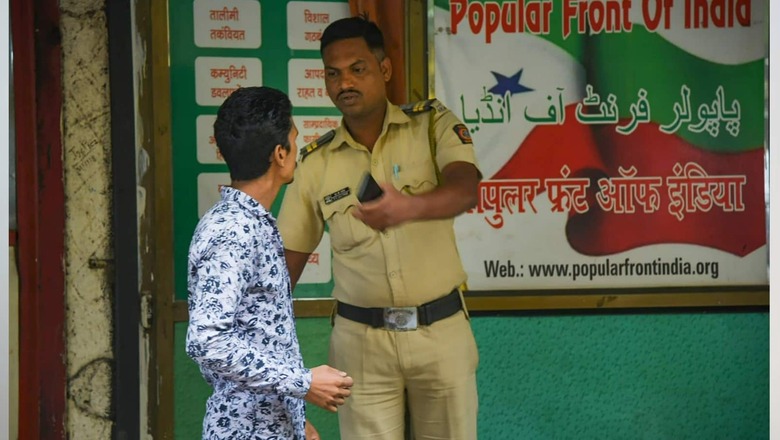
views
The decision to designate the Popular Front of India (PFI) as an “unlawful association” on September 28 is the most concrete signal yet of the government’s intent to stem the growing radicalisation of Muslim youth. The decision, around which media speculation had been swirling for weeks, was immediately preceded by pre-emptive nationwide arrests of the PFI leadership on the 22nd and 27th.
The decision will now have to be referred, in terms of the Unlawful Activities Prevention Act, to a Tribunal consisting of a sitting High Court judge for determining whether or not there existed “sufficient cause” for declaring the organisation unlawful. The office-bearers of the PFI will be presented an opportunity by this Tribunal to present their case. A final decision about the fate of the PFI should be known within six months.
Given the media coverage that has been devoted to the issue, most readers will be at least vaguely familiar with the ideology and sphere of activities of the PFI. Yet, in order to understand why the movement needed to be banned outright, one must examine the full historical context behind the PFI’s programme.
The PFI was formed in 2006 through the merger of three Islamist organisations in South India. By far the strongest amongst these was the National Development Front (NDF), whose activities were mostly confined to Kerala. As a consequence, the Muslim-dominated districts of north Kerala continued for some time after the merger to serve as the PFI’s principal base of operations, and its leadership and cadre leaned toward Keralites.
The NDF, in its turn, was one amongst a host of radical organisations founded in the aftermath of the demolition of the Babri Masjid in 1992. Its leading members had, even by the NDF and PFI’s own admission, served as prominent organisers of the Students Islamic Movement of India (SIMI), a terrorist group that was formed in 1977 and was involved in major terrorist attacks across India. (SIMI has remained banned since 2001.)
Significantly, the PFI’s founding chairman, EM Abdul Rahman, served as the national secretary of SIMI for over a decade. P Koya, a firebrand ex-professor who is the PFI’s most effective recruiter, is also credited with having drafted the SIMI’s seminal manifesto. In fact, the government of Kerala, in 2012 (ie at a time when the Congress-led UDF was in power), had declared that the PFI was nothing but SIMI under a different name.
There is, however, a crucial distinction between SIMI and PFI. SIMI, while in existence, had openly declared as its aim the establishment of Islamic rule in India. It stressed the essential political unity of the global Muslim community, or the ummah, and the need for jihad in order to create an Islamic caliphate. In contrast, the leaders of the PFI, undoubtedly mindful of the folly of SIMI’s undisguised programme, settled on a more strategic approach.
PFI’s bare-bones official manifesto, which was available online before the ban, merely contained anodyne references to the “social and educational development” of minorities and “the protection of human rights in India”. Conspicuously absent from the official policy statements and press releases of the PFI was any mention of the systematic training and arming of cadres or of information that hinted at the assiduous efforts it was undertaking to forge ties with pan-Islamic movements based out of the Middle East.
This scrupulously crafted image helped the PFI marshal a degree of deniability against initial allegations by the Kerala Police that it was in reality focused on radicalising youth into a version of political Islam that conflicted with the supremacy of Indian law. Even as charges of murder and other violent crimes mounted against the PFI in Kerala, it was able to expand its influence far beyond the state. The first steps toward expansion were visible by the early 2010s in adjoining South Indian states; the coastal belt of Karnataka, which shares cultural and historical links with Kerala, was a particularly fertile ground for its activities.
By 2013, the Kerala Police had alleged that the PFI was giving training in the use of firearms at various forest camps in Kerala and Karnataka. (Raids at various such camps in Kerala yielded caches of explosive material, weapons of different kinds and a catalogue of jihadi reading material.) Similar camps were later unearthed in various parts of Telangana as well. Symbolic crimes such as the Taliban-style brutalisation of those it deemed guilty of blasphemy and the periodic assassination of RSS workers in Kerala served not only to instil terror in Hindus and Christians but also as a powerful recruitment tactic that distinguished the PFI from run-of-the-mill Islamist organisations. In a sign of its growing ambition, the PFI relocated its headquarters from Kozhikode to Delhi around this time.
The extent of the PFI’s growth, however, is best illustrated in recent charges by the police of several North Indian states (including states in which the BJP is not in power) that PFI activists have been responsible for orchestrating communal riots and fomenting subversion against the Indian state. The most remarkable of such cases emerged after the arrest of three PFI activists in Patna, Bihar (where Nitish Kumar, a self-proclaimed champion of Muslim rights, directly oversees the police) in July 2022 for conspiring to target a forthcoming visit by the Prime Minister.
Amongst the evidence collected from the accused was a document labelled “India Vision-2047”, which outlined a plan for the establishment of Islamist rule in India by the time India completes 100 years of independence. While the PFI leadership promptly declared the document to be a fabrication, similar playbooks were later recovered from PFI members in UP and Maharashtra.
In retrospect, one can easily locate a turning point in the PFI’s national campaign. This coincided with the protests against the Citizenship Amendment Act (CAA), which culminated in mob violence that rocked various North Indian cities in 2019-20. According to law enforcement agencies, PFI chapters were responsible for a number of such incidents. By initiating an extreme response at a time when mass hysteria had gripped the Muslim community, and by dint of their workers’ ideological commitment, the PFI appears to have carved out a sizeable constituency for itself across towns and cities in which it was hitherto largely absent.
The clearest example of this is provided by the strong organisational effort that made possible the extension of the anti-CAA protests in Delhi — despite reassurances having been provided to Indian Muslims by the Prime Minister himself — up until the visit of the American President in late February 2020. The sustained build-up of belligerence around the CAA issue, and the ensuing communal riots, allowed the working out of a concerted plan to tarnish India’s image at a time when the international media’s attention was focused on it. It is worth noting that the Delhi Police has stated on record that the initial spark for these riots was provided by PFI workers.
The PFI as an organisation, however, has distanced itself from the members who stand accused of committing and abetting violence. It argues that at best the members are liable to be prosecuted on an individual basis and that no culpability for these acts can be attributed to the organisation itself, even as it claims that the evidence found by the police forces of a dozen states against its members is all doctored.
In the absence of any officially sanctioned document calling for violence against non-Muslims, it says, its activities cannot be legally proscribed. As any Investigating Officer knows, however, the existence of a conspiracy is not precluded by the absence of a foundational document or plan; it is the accumulation of countless serious crimes over a sustained period of time that points to the conclusion that the PFI’s activities, if not its undeclared ideology, tend to foster violence and public disorder.
Some insight about the PFI’s programme is provided by the teachings and work of the Muslim Brotherhood (an organisation that is mainly active in the Arab world and Turkey), which serves as the lodestar for political Islam across the globe. Syed Qutb, a long-time leader of the Brotherhood who laid down the guiding principles of Islamism, underscored in his works the importance of communicating the movement’s ideology about the imperative of aggressive jihad (as opposed to an internal, spiritual kind) and the creation of a pan-Islamic global order through professional and social organisations whose activities would be less vulnerable to outright bans.
This approach has allowed the Brotherhood to penetrate civic institutions such as the press, the judiciary and even the executive in countries such as Egypt (prior to the most recent coup), Turkey and Tunisia. In Turkey, for instance, charitable hospices run by the Brotherhood-inspired Naqshbandis could survive waves of bans imposed by the secular state. Within the span of a generation, ideas first spread from these hospices have converted an electorate that believed in the necessity of the secular state to one that eagerly supports efforts to build a global Islamic order.
Under the guise of such charitable and religious work, the Brotherhood lays the groundwork of bringing around Muslims to a conservative, pan-Islamic outlook; this creates a reservoir of sympathy that can then be tapped into by avowedly terrorist organisations such as Al-Qaeda and ISIS.
It is worth noting that, according to the Enforcement Directorate, the money trail of most of the criminal activities in which PFI members stand implicated leads to the Rehab India Foundation, an ostensibly charitable group that worked under the umbrella of the PFI. Strikingly, various youth that underwent radicalisation through contact with the PFI’s programme later joined groups such as ISIS and Jamaat-ul-Mujahideen Bangladesh.
The parallels with the Brotherhood, however, do not end there. The “hub-and-spoke” network that the PFI operated closely imitates the manner in which the Brotherhood organises its activities. In fact, it has been reported that the ideological training of PFI members consists of studying the works of Brotherhood ideologues such as Syed Qutb. While the PFI denies any links with pan-Islamic groups, central agencies have reported that its leaders were in regular touch with Brotherhood proxies in Turkey and Qatar; hawala inflows into the PFI suggest that the support on offer was not merely ideological.
Much as the Brotherhood provided a model for the PFI’s activities, its resilience in the face of repeated crackdowns by Arab governments provides cause for proceeding with vigilance in the aftermath of the PFI’s ban. In fact, unlike in the Middle East, it would not be possible to lock up thousands of PFI followers on suspicion alone; the PFI’s cadre, aided by modern communication technology, could thus manage to regroup under a different banner. Furthermore, commentators in the Malayalam press who have followed the PFI’s rise closely attest to the strength of the PFI’s second-rung leadership. This, coupled with the sheer scale of the PFI’s operations, means its future presents a problem of a different order of magnitude than did SIMI.
Faced with an issue that directly concerns national security, one may have expected that opposition parties would rally behind the decision to ban the PFI. Sadly, this has not come to pass. The Congress and the RJD, to say nothing of the AIMIM, could muster no more than an unsubstantiated and false equivalence between the banned outfit and the RSS.
There can be no doubt that the appeasement of the Muslim community passed off as leadership by these parties has throttled effective political participation by Indian Muslims, which in turn creates space for radical groups such as the PFI. Unless efforts are made by the entire country to create a vision of citizenship for Indian Muslims that competes with entrenched notions of appeasement and separateness, we may find ourselves in the same position decades hence.
Read all the Latest Opinion News and Breaking News here




















Comments
0 comment